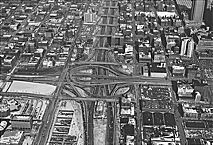| Entries |
| E |
|
Eminent Domain
|

|
The public was effectively cut off from access to the south lakefront between the 1850s and 1920s by the 10-track mainline of the Illinois Central. The Lake Front Ordinance of 1919 provided some relief, but too little and too late. By 1940, the city's worst slums festered on the Near South Side. Fighting for their survival, affected hospitals and universities lobbied in Springfield and Washington to delegate powers of eminent domain to themselves and to add slum prevention and eradication to eligible public purposes. The resulting state legislation between 1941 and 1953 served as models for the National Housing Acts of 1949 and 1954, and produced the Lake Meadows, Prairie Shores, and Hyde Park A & B residential developments.
The Encyclopedia of Chicago © 2004 The Newberry Library. All Rights Reserved. Portions are copyrighted by other institutions and individuals. Additional information on copyright and permissions.